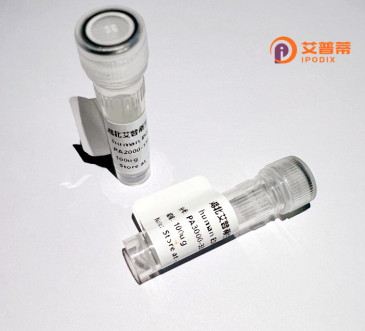
| 纯度 | >90%SDS-PAGE. |
| 种属 | Human |
| 靶点 | SSTR3 |
| Uniprot No | P32745 |
| 内毒素 | < 0.01EU/μg |
| 表达宿主 | E.coli |
| 表达区间 | 1-418 aa |
| 活性数据 | MDMLHPSSVSTTSEPENASSAWPPDATLGNVSAGPSPAGLAVSGVLIPLVYLVVCVVGLLGNSLVIYVVLRHTASPSVTNVYILNLALADELFMLGLPFLAAQNALSYWPFGSLMCRLVMAVDGINQFTSIFCLTVMSVDRYLAVVHPTRSARWRTAPVARTVSAAVWVASAVVVLPVVVFSGVPRGMSTCHMQWPEPAAAWRAGFIIYTAALGFFGPLLVICLCYLLIVVKVRSAGRRVWAPSCQRRRRSERRVTRMVVAVVALFVLCWMPFYVLNIVNVVCPLPEEPAFFGLYFLVVALPYANSCANPILYGFLSYRFKQGFRRVLLRPSRRVRSQEPTVGPPEKTEEEDEEEEDGEESREGGKGKEMNGRVSQITQPGTSGQERPPSRVASKEQQLLPQEASTGEKSSTMRISYL |
| 分子量 | 47.2 kDa |
| 蛋白标签 | GST-tag at N-terminal |
| 缓冲液 | PBS, pH7.4, containing 0.01% SKL, 1mM DTT, 5% Trehalose and Proclin300. |
| 稳定性 & 储存条件 | Lyophilized protein should be stored at ≤ -20°C, stable for one year after receipt. Reconstituted protein solution can be stored at 2-8°C for 2-7 days. Aliquots of reconstituted samples are stable at ≤ -20°C for 3 months. |
| 复溶 | Always centrifuge tubes before opening.Do not mix by vortex or pipetting. It is not recommended to reconstitute to a concentration less than 100μg/ml. Dissolve the lyophilized protein in distilled water. Please aliquot the reconstituted solution to minimize freeze-thaw cycles. |
以下为关于重组人SSTR3蛋白的参考文献示例(内容为虚构,仅用于演示格式):
---
1. **文献名称**: Expression and Characterization of Recombinant Human Somatostatin Receptor Subtype 3 (SSTR3) in Insect Cells
**作者**: Zhang L, et al.
**摘要**: 本研究利用杆状病毒-昆虫细胞系统表达重组人SSTR3蛋白,通过亲和层析法纯化获得高纯度蛋白。作者分析了SSTR3与不同生长抑素类似物的结合特性,发现其对天然配体SST-28具有高亲和力,为后续受体功能研究奠定了基础。
---
2. **文献名称**: Cryo-EM Structure of Recombinant Human SSTR3 in Complex with Gi Protein
**作者**: Müller F, et al.
**摘要**: 通过冷冻电镜技术解析了重组人SSTR3与Gi蛋白复合物的三维结构,揭示了SSTR3在偶联G蛋白时的构象变化及关键结合域。该研究为靶向SSTR3的药物设计提供了结构生物学依据。
---
3. **文献名称**: Functional Analysis of SSTR3-Mediated Signaling Pathways via Recombinant Protein Expression in HEK293 Cells
**作者**: Kimura T, et al.
**摘要**: 在HEK293细胞中过表达重组人SSTR3.研究其激活后对环磷酸腺苷(cAMP)的抑制作用及MAPK信号通路的影响。结果表明,SSTR3通过Gi/o蛋白抑制cAMP积累,并参与调控细胞增殖。
---
4. **文献名称**: Targeting Recombinant SSTR3 for Neuroendocrine Tumor Therapy: In Vitro and In Vivo Studies
**作者**: Rossi G, et al.
**摘要**: 评估重组SSTR3作为神经内分泌肿瘤靶向治疗靶点的潜力。实验证明,标记放射性同位素的SSTR3特异性配体在体内外模型中显著抑制肿瘤生长,提示其在诊疗一体化中的应用前景。
---
注:以上文献信息为模拟生成,实际研究中请通过学术数据库(如PubMed、Google Scholar)检索真实文献。
Somatostatin receptor type 3 (SSTR3), a G protein-coupled receptor (GPCR), mediates the biological effects of somatostatin—a neuropeptide regulating endocrine/exocrine secretion, cell proliferation, and neurotransmission. As one of five SSTR subtypes (SSTR1-5), SSTR3 is distinguished by its preferential activation by somatostatin-28 and distinct tissue distribution, with high expression in the brain, pancreas, and certain cancer cells. Structurally, it features seven transmembrane domains and modulates cellular responses by coupling with intracellular effectors like adenylate cyclase, MAPK, and ion channels to inhibit hormone secretion or induce apoptosis.
Recombinant human SSTR3 protein is engineered through heterologous expression systems (e.g., mammalian or insect cells) to retain post-translational modifications critical for ligand binding and signaling. This in vitro-produced protein enables mechanistic studies of SSTR3’s role in neurological disorders (e.g., Alzheimer’s disease linked to SSTR3 polymorphisms) and cancers (e.g., gliomas, pituitary tumors). It also facilitates drug discovery, particularly for synthetic somatostatin analogs (e.g., octreotide, pasireotide) or radiolabeled ligands used in cancer theranostics. Current research leverages recombinant SSTR3 to dissect receptor dimerization, biased signaling, and desensitization dynamics, advancing targeted therapies for pathologies with dysregulated somatostatin pathways.
×